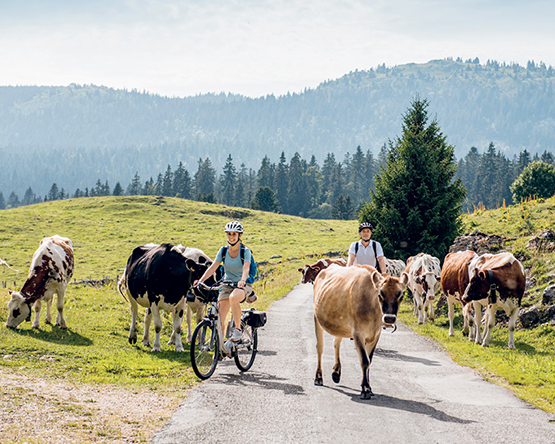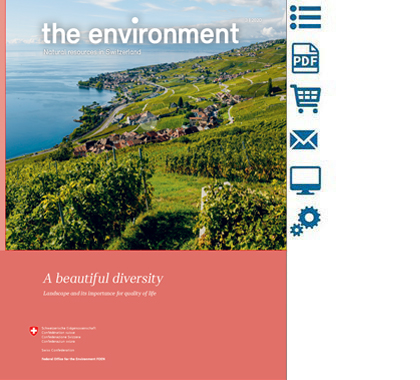The landscape is an asset in many ways, not least in the development of peripheral regions. But capitalising on Switzerland’s diverse landscapes also means protecting and looking after them.
Text: Kaspar Meuli

(pictured: the Jura Vaudois Nature Park).
© Schweiz Tourismus
Electric bikes are now a regular sight outside the Brasserie Tonnebière in the medieval town ofSt-Ursanne. The brewery is located on the Route Verte, a tourist route for e-bikers traversing six regional nature parks and spanning the entire Jura Arc. There is plenty to discover along the way. The Parc du Doubs even has its own beer, “L’Apronne,” made entirely from ingredients sourced within the park. The organic barley comes from Epiquerez and is malted in Delémont, and several farmers in the park grow hops, although the quantity harvested is not yet quite enough to meet demand. The beer is then brewed at the Brasserie Tonnebière.
This inspiring story about a unique product perfectly encapsulates the idea behind the Route Verte, which opened in 2018. “Stop off along the way to discover the secrets of the beautiful landscapes around you”, its website proclaims. “The parks’ residents are proud of their natural and cultural heritage and are passionate about conserving these precious resources and treating them with respect. In return, nature rewards them with the ingredients to make delicious regional products.”
One example is the Jaune longue du Doubs, an old, nearly extinct variety of carrot. It has a distinctive, slightly sweet flavour and is perfectly adapted to the area’s high altitudes. The nature park has now launched a campaign to use the yellow carrot as a catalyst for reviving culinary traditions and old knowledge from the Jura, and it is proving successful, with various local eateries, from country inns to fine-dining restaurants, featuring the rare vegetable on their menus. Three of these establishments are located right on the Route Verte and are delighted at the growing number of e-bikes in their car parks.
Nature and culture
This new e-bike route for nature and culture enthusiasts appears to have struck a chord, with around 27,000 people researching the Route Verte online in 2019 and an estimated 1,000 e-bikers riding all or part of the route last season. Cycling the entire length from Schaffhausen to Geneva takes seven days. Those without their own vehicle can rent an e-bike on site, and e-cyclists can even ask for their luggage to be transported from one overnight stop to the next. The promoters of this “eco-friendly activity holiday” are pleased with the growing number of visitors that the route is bringing to the nature parks – especially when they take time to enjoy the beauty of the landscape and stay overnight in the region. But it isn’t all about hotel bookings and turnover. “We don’t just promote tourism, we also have an awareness-raising remit”, explains Nadège Graber from the Parc du Doubs. The aim is for people travelling the Route Verte to also learn something about the history and significance of Swiss landscapes – and really take the time to absorb the surroundings. “We encourage soft mobility”, says the tourism and culture project manager, “partly because we want to show our visitors how important it is to conserve nature.”
Landscape promoting development
In other words, landscape on the Route Verte is not just a backdrop: it is a core part of the offering – and that is something new. Breathtaking mountain and lake scenery has been integral to Swiss tourism from the outset, but there has been very little attempt to promote a real understanding of the landscape. Landschaft als Leitthema für eine nachhaltigeRegionalentwicklung (Landscape as a guiding theme for sustainable regional development) is the title of a FOEN-commissioned study published in 2019. The study involved researching 111 examples of innovative approaches to landscape, in Switzerland and abroad, of which 12 from Switzerland were then analysed in detail. The central question was whether landscape has the potential to promote sustainable regional development. According to the authors, the answer is a resounding yes. Landscape-focused regional development leads, for example, to a greater appreciation of the landscape among local people. It can also generate addedvalue and enhance stakeholder cooperation.
For proof that a landscape project can promote integration, we need look no further than the Route Verte. The scheme was devised by the Jura Arc’s six regional nature parks, spread acrossnine cantons. Their idea was to create a shared identity that would set them apart from the Alpine parks. The Route Verte’s marketing and activities are coordinated by the Swiss Parks Network.Rianne Roshier, the woman responsible, explains:“We managed to bring together around one table a number of tourism organisations that would otherwise never have talked to each other.” But she stresses that it is local actors who keep the project going.
Developing its own ideas rather than just copying existing tourism formulas is what sets landscape-related regional development apart. “It’s not enough to say: let’s do another nature trail!” explains Daniel Arn, who is responsible for regional policy at the FOEN. “You have to focus more on the things that make you distinctive.” The landscape specialist refers to a real “paradigm shift” in regional development.
For too long, he says, only tried-and-tested solutions were replicated, but this leads to a loss of regional diversity. Describing the new development approach, he says: “The goal is uniqueness. But for that you first need to understand which natural and cultural features define a landscape and what makes it special. Only then can development projects be taken forward.”
Support for innovative projects
A key player in Swiss tourism policy is the State Secretariat for Economic Affairs SECO. SECO invests primarily through the Innotour programme, supporting projects that promote innovation, cooperation and knowledge development in tourism. The Swiss Parks Network and the Route Verte are among the beneficiaries. “Bottom-up projects such as the Route Verte are particularly good for promoting development in the park regions”, explains Mireille Lattion, who is responsible for Innotour at SECO.
Back to the e-bike route through the nature parks of the Jura, where there is no shortage of ideas on how to harness the potential of people, their products and the landscape that shapes them. Les Rottes, for example, is an organic farm in Saint-Brais, surrounded by the wooded pastures of the Franches-Montagnes. It makes a very special Tête de Moine cheese: not the industrially produced kind sliced with the round Girolle curler, but one made to an old recipe from a time when Tête de Moine was still scraped with a knife. The recipe was unearthed by Bernard Froideveaux, a now-retired farmer and cheese maker, following years of research. Bernard was very keen to pass on his knowledge beforeretiring from artisanal cheese production, and he now has three young successors in the Parc du Doubs, ensuring that the Tête de Moine AOP fermière Bio will continue to be made in the future – another inspiring story very much in the spirit of the Route Verte.
Last modification 02.09.2020






